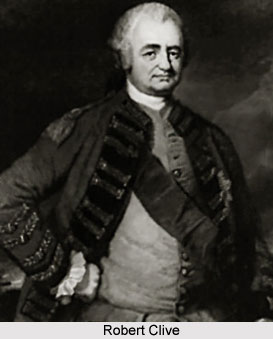 The Dual Government of Bengal was a double system of administration, which was introduced by Robert Clive. The British East India Company obtained the actual power; where as the responsibility and charge of administration was entrusted to the Nawab of Bengal. Under this dual system of governance, the British administration acquired both the functions of the Diwani or revenue and Nizamat or civil administration of Bengal from 2 distinct sources, Diwani from the Mughal emperor and Nizamat from the Nawab of Bengal. The British East India Company was authorized to accumulate revenues of the Bengal province as the Diwan. Moreover with the right to appoint the Deputy Subahdar, the British obtained the designation to control the police and judicial powers or the Nizamat. The Nawab or Subedar of Bengal, as Viceroy of the Mughal Emperor, exercised two functions namely the Diwani and the Nizamat. The Diwani was concerned with revenue and civil justice and the Nizamat with military power and criminal justice.
The Dual Government of Bengal was a double system of administration, which was introduced by Robert Clive. The British East India Company obtained the actual power; where as the responsibility and charge of administration was entrusted to the Nawab of Bengal. Under this dual system of governance, the British administration acquired both the functions of the Diwani or revenue and Nizamat or civil administration of Bengal from 2 distinct sources, Diwani from the Mughal emperor and Nizamat from the Nawab of Bengal. The British East India Company was authorized to accumulate revenues of the Bengal province as the Diwan. Moreover with the right to appoint the Deputy Subahdar, the British obtained the designation to control the police and judicial powers or the Nizamat. The Nawab or Subedar of Bengal, as Viceroy of the Mughal Emperor, exercised two functions namely the Diwani and the Nizamat. The Diwani was concerned with revenue and civil justice and the Nizamat with military power and criminal justice.
The Nawab granted practically the Nizamat to the Company in 1765. The Mughal Emperor Shah Alam granted Diwani to the English Company in August 1765. Thus the Company held Diwani from the Emperor and the Nizamat from the Subedar. The difficulty was created by the fact that the servants of the Company did not undertake duties as Diwan or Nizam in their own person. The nominal head of the administration was a Deputy Naib or Nawab whom the Nawab bound himself to appoint with their sanction. A similar Deputy was appointed for Bihar. The whole administration was carried on for many years through the agency of native servants. In 1769, English supervisors were appointed to control the native revenue officers, but they made confusion worse confounded and corruption also increased. Such was the dual system of Government set up in Bengal by Robert Clive. The Nawab was merely a puppet in the hands of the British Government of India.
The Nawab of Bengal province was under their dominion and depended upon them for his very existence. Lord Clive could have abolished his office and had assumed control of the Government directly. The great disadvantage of the scheme was that it separated power from responsibility. The British were given control over the province but they did not feel any responsibility for its administration and could not be held responsible for anything done badly. The weakness of the system became clear in 1770 when a severe famine broke out in Bengal. The servants of the Company did not feel any duty towards the people who were left to die in thousands.
However the dual system of Government, set up in 1765, had certain immediate advantages. It was suited to the exigencies of time. It secured that control over the Nawab which was regarded as the most pressing need of the time. It also secured protection against the complaints of the foreign powers and demands of the Home Government. Clive knew that the ostensible assumption of power contributed to produce unyielding English opposition to the schemes of Dupleix. The writs of the Emperors or Parwanas of the Nawab, though valueless without the support of English power, could not fully be discounted at Paris or at The Hague without a serious breach of diplomatic etiquette. It was thought that something less than the assumption of full dominion would be less likely to excite legal difficulties in England to provoke the interference of Parliament.
Formally, the abolition of the dual government did nothing more than that the Company was to collect its revenues through the agency of its own servants. In reality it meant becoming responsible for the whole of civil administration. The first step towards abolition was the abolition of the offices of the Naib Diwans of Bengal and Bihar and the persecution of Mohammad Razqa Khan and Raja Shitab Rai for peculation. After a long trial, both of them were acquitted. Although Warren Hastings was opposed to it, it served its purpose.
The dual system of Government of Bengal, established by Robert Clive, was abolished by Warren Hastings as it was not intended to last for ever. It was merely a stop-gap arrangement with a view to tide over the difficulties confronting the English in 1765.



















